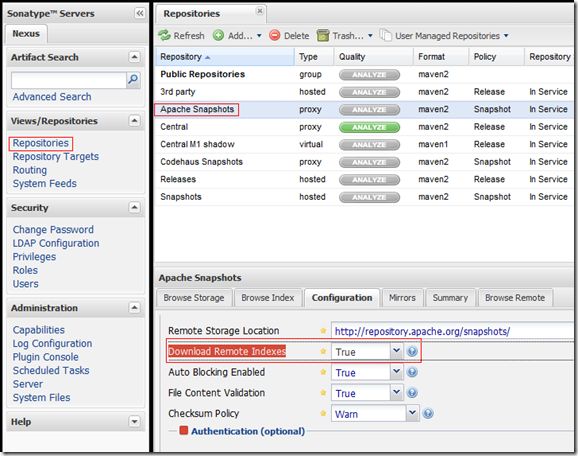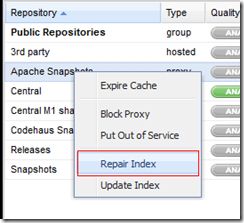windows下集成maven+eclipse开发环境一:安装使用maven私服nexus
1. Nexus 分为开源版和企业版,开源版基于 GPLv3 许可证。开源版本主要特性有:
1) 较小的内存占用(最少为 28MB )
2) 基于 ExJS 的友好界面
3) 基于 Restlet 的完全 REST API
4) 支持代理仓库、宿主仓库和仓库组
5) 基于文件系统,不需要数据库
6) 支持仓库索引和搜索
7) 支持从界面上传 Maven 构件
8) 细粒度的安全控制。
2. Nexus 的下载地址是: http://nexus.sonatype.org/downloads/ 。有两种安装包:一种是自带 jetty 容器的 Bundle 包,另一种是不带 web 容器的 war 包。
3. Bundle 包安装目录下会有两个目录: nexus-webapp-x.x.x 包含了 Nexus 运行所需的文件。 sonatype-work 下包含Nexus 生成的配置文件、日志文件、仓库文件等。 Nexus 默认访问地址是: http://localhost:8081/nexus 。
如需要改变端口,可以修改 nexus-webapp-x.x.x/conf/plexus.properties 文件中的 application-port 属性即可。
4. Nexus 的仓库类型有四种: group (仓库组)、 hosted (宿主)、 proxy (代理)和 virtual (虚拟)。仓库组没有具体的内容,它会转向其包含的宿主仓库或代理仓库获得实际构件的内容。宿主仓库主要是用来存放一些组织内部的构件,或由于版权原因不能放在公共 Maven 仓库中的构件的。代理仓库则是用来代理远程仓库,它会从远程仓库下载并缓存构件。虚拟仓库用于 maven1 格式的仓库,会动态地将仓库内容格式进行转换。
5. Nexus 内置了如下仓库:
1) Maven Central :代理 Maven 的中央仓库,策略为 release
2) Releases :策略为 Release 的宿主类仓库,用来部署组织内部的 release 版本构件
3) Snapshots :策略为 Snapshot 的宿主类仓库,用来部署组织内部的 release 版本构件
4) 3rd party :策略为 Release 的宿主类仓库,用来部署无法从公共仓库获得的第三方 release 版构件。
5) Apache Snapshots :代理 Apache Maven 仓库,策略为 Snapshot
6) Codehaus Snapshots :代理 Codehaus Maven 仓库,策略为 Snapshot
7) Google Code :代理 Google Code Maven 仓库,策略为 Release
8) Java.net – Maven 2 :代理 Java.net Maven 仓库,策略为 Release
9) Public Repositories :将上述策略为 Release 的仓库聚合并通过一致的地址提供服务。
10) Public Snapshot Repositories :将上述策略为 Snapshot 的仓库聚合并通过一致的地址提供服务。
6. 创建 Nexus 宿主仓库时,仓库会默认地存放在 sonatype-work/nexus/storage/repository-id/ 下,也可以填写 Override Local Storage Location 自定义仓库的存储路径。同时可以设置以下选项:
Deployment Policy :只读(禁止部署)、关闭重新部署(同一构件只能部署一次)或允许重新部署。
Allow File Browser :设置是否允许在 Repository 的 Browse Storage 选项卡中浏览仓库。
Include in Search :设置是否对该仓库进行索引并提供搜索。
Publish URL :设置是否通过 URL 提供服务,如为 false ,访问该仓库的地址时会得到 404
Not Found Cache TTL :缓存未找到文件信息的时间(此时间内不再去找,直接返回没找到)
7. 创建 Nexus 代理仓库时,除了设置远程仓库的地址和认证信息外,还可以设置以下选项:
Download Remote Indexes :设置是否下载远程仓库的索引。(下载远程仓库的索引后,即使没有缓存远程仓库的构件,用户依然能搜索或浏览构件的基本信息)
Checksum Policy :设置校验和出错时,是忽略、记录警告信息还是拒绝下载。
Artifact Max Age :设置多久更新一次 Artifact (对于策略为 release 的仓库,可以设置为 -1 ,也就是不更新)
Metadata Max Age :设置多久更新一次 metadata 。
8. 仓库组没有 Release 和 Snapshot 的区别,创建时会让用户选择由哪些宿主仓库或代理仓库构成。仓库组所包含的仓库的顺序决定了仓库组遍历它们的次序,所以最好将常用的仓库放在前面。
9. Nexus 通过维护仓库的索引来提供搜索功能。为了能搜索 Maven 中央仓库,需要设置 Nexus 中的 Maven Central 代理仓库下载远程索引,默认这个设置是关闭的。只要远程仓库提供 nexus-indexer 形式的索引, Nexus 就可以下载它的索引,同时 Nexus 也可以对宿主仓库和代理仓库进行索引。仓库有了索引之后,可以在其 Browse Index 选项卡中浏览仓库内容的树形结构。
10. Nexus 提供了关键字搜索、 GAV 搜索、类名搜索和校验和搜索。
11. 我们可以在 settings.xml 中配置 Maven 私服,这样就可以对本机的所有 Maven 项目有效。但是 settings.xml 中没有Repositories 和 pluginRepositories 。但可以设置如下信息:
- <profiles>
- <profile>
- <id>nexus</id>
- <repositories>
- <repository>
- <id>nexus</id>
- <name>Nexus</name>
- <url>http://localhost:8081/nexus/content/groups/public/</url>
- <releases><enabled>true</enabled></releases>
- <snapshots><enabled>true</enabled></snapshots>
- </repository>
- </repositories>
- <pluginRepositories>
- <pluginRepository>
- <id>nexus</id>
- <name>Nexus</name>
- <url>http://localhost:8081/nexus/content/groups/public/</url>
- <releases><enabled>true</enabled></releases>
- <snapshots><enabled>true</enabled></snapshots>
- </pluginRepositories>
- </profile>
- </profiles>
- <activeProfiles>
- <activeProfile>nexus</activeProfile>
- </activeProfiels>
同时我们可以 settings.xml 中将 Maven 私服设为所有远程仓库的镜像,这样就能让所有 Maven 下载请求都仅仅通过Nexus :
- <mirrors>
- <mirror>
- <id>nexus</id>
- <mirrorOf>*</mirrorOf>
- <url>http://localhost:8081/nexus/content/groups/public</url>
- </mirror>
- </mirrors>
12. 可 以在 settings.xml 中的 profile 元素中添加以下元素:
- <repositories>
- <repository>
- <id>central</id>
- <url>http://central</url>
- <releases><enabled>true</enabled></releases>
- <snapshots><enabled>true</enabled></snapshots>
- </repository>
- </repositories>
- <pluginRepositories>
- <pluginRepository>
- <id>central</id>
- <url>http://central</url>
- <releases><enabled>true</enabled></releases>
- <snapshots><enabled>true</enabled></snapshots>
- </pluginRepository>
- </pluginRepositories>
仓库及插件仓库的 id 为 central ,覆盖了超级 POM 中央仓库的配置它们的 url 已无关紧要,因为所有请求都会通过镜像访问私服地址。这样配置的主要目的是开放对 snapshot 版本下载的支持。
其实只要项目配置中有一个依赖仓库开放了 snapshot 策略就行。而且如果私服仓库组中的仓库不支持snapshot 也没用。
13. 可以在 POM 中设置构件发布到哪个远程仓库,将这个仓库设置成 Nexus 私服:
- <distributionManagement>
- <repository>
- <id>nexus-releases</id>
- <name>Nexus Releases Repository</name>
- <url>http://localhost:8081/nexus/content/repositories/releases/</url>
- </repository>
- <snapshotRepository>
- <id>nexus-snapshots</id>
- <name>Nexus Snapshots Repository</name>
- <url>http://localhost:8081/nexus/content/repositories/snapshots/</url>
- </snapshotRepository>
- </distributionManagement>
同时在 settings 中的配置 Nexus 的认证信息:
- <servers>
- <server>
- <id>nexus-releases</id>
- <username>admin</username>
- <password>password</username>
- </server>
- <server>
- <id>nexus-snapshots</id>
- <username>admin</username>
- <password>password</username>
- </server>
- </servers>
同时, Nexus 也支持在 repository 的 Artifact Upload 选项卡中手动上传构件。
14. 一个 Nexus 用户可以被赋予一个或多个角色,一个角色可以包含一个或多个权限,也可以包含一个或多个其他角色。
15. N exus 预定义了三个用户:
1) admin :对 Nexus 服务的完全控制权限,默认密码为 admin123
2) deployment :能够访问 Nexus ,浏览仓库内容,搜索并且上传部署构件但无法配置 Nexus ,默认密码为:deployment123
3) anonymous :对应所有未登录用户,可以浏览和搜索仓库
16. 我们可以为不同的实际项目配置不同的宿主仓库,并为这些宿主仓库建立他们对应的增、删、改、查的权限(通过导航栏中 Privileges 链接),并将这些权限赋予不同的角色(通过导航栏中 Roles 链接)
17. Nexus 提供了如下一系列可调度任务( Scheduled Tasks )来方便用户管理系统。用户可以设定这些任务的运行频率。
1) Download Indexes :为代理仓库下载远程索引
2) Empty Trash :清空 Nexus 的回收站
3) Evict Unused Proxied Items From Repository Caches :删除代理仓库中长期未被使用的构件缓存。
4) Expire Repository Caches :清空代理仓库的缓存,重新去获取远程仓库的信息。
5) Publish Indexes :将仓库索引发布成可供 m2eclipse 和其他 Nexus 使用的格式。
6) Purge Nexus TimeLine :删除 Nexus 时间线文件,该文件用于建立系统的 RSS 源。
7) Rebuild Maven Metadata Files :基于仓库内容重新创建 metadata 。
8) ReIndex Repositories :为仓库重新编纂索引。
用户可以通过导航栏中 Scheduled Tasks 链接创建可调度任务。
18. 其他私服软件还有: Archiva ,它是 Apache 的顶级项目,地址为 http://achiva.apache.org 。
JFrog 的 Artifactory ,它将构件存储在数据库中,地址为 http://www.jfrog.org/products.php 。
下载最新的Nexus安装包。
解压压缩包,进入nexus-2.0.4-1-bundle\nexus-2.0.4-1\bin\jsw目录,该目录中存放了对应各种系统的安装文件。因为这里只阐述windows下面的安装方法,所以请进入windows-x86-32(对应32位系统)或者windows-x86-64(对应64位系统)文件夹。首先,我们先将nexus注册成windows服务,双击install-nexus.bat即可;然后双击start-nexus.bat启动nexus服务;另外stop-nexus.bat是停止运行nexus服务,uninstall-nexus.bat是卸载nexus服务。
至此为止nexus就已经全部安装完成了,下面看看我们该怎样使用它。
在浏览器输入地址:http://127.0.0.1:8081/nexus/ 就可以访问我们新搭建的maven私服了。
备注:
更改访问端口:修改nexus-webapp-2.0.2/conf/plexus.properties
我们先从右上角(Log In)登录,默认的账号密码分别是:admin/admin123
下面你需要依次做两件事情:
1、修改当前密码。页面左边,Security菜单下面的Change Password可以更改当前密码
2、开启远程索引下载,作用是在eclipse等IDE里面使用maven搜索导入第三方jar包的时候,就可以直接从网络上现有的资源中down下来,比如想SSH,要用到的相关jar包,基本
nexus中的现有仓库中都会有。要开启远程索引,可按以下步骤操作:
从页面左边的Views/Repositories菜单下面的Repositories进入仓库列表,然后选择一个仓库,点击下方的Configuration标签,找到Download Remote Indexes项,将其改为
true,如图:
然后在刚才选择的仓库上,右键,Repair Index,如图:
这样,nexus就会从远程仓库中更新索引。
至此为止,nexus的安装和最基本的配置,已经完成,已经能够满足maven的使用了,其他的功能,诸如搜索,自建仓库,上传第三方jar包等操作,在以后的章节中会涉及到。
在下一章会介绍安装maven,并将nexus配置为maven的中央仓库。
4、修改settings.xml文件:增加server配置
- <servers>
- ……
- <server>
- <id>nexus</id>
- <username>admin</username>
- <password>admin123</password>
- </server>
- <server>
- <id>nexus-snapshot</id>
- <username>admin</username>
- <password>admin123</password>
- </server>
- </servers>
此处的id将于pom文件中的repository.id 对应
5、修改pom文件:
- <!-- 设定使用Release插件发布的仓库服务器 如有Nexus私服, 取消注释并指向正确的服务器地址. -->
- <distributionManagement>
- <repository>
- <id>nexus</id>
- <name>Team Nexus Release Repository</name>
- <url>http://localhost:8081/nexus/content/repositories/releases</url>
- </repository>
- <snapshotRepository>
- <id>nexus-snapshot</id>
- <name>Team Nexus Snapshot Repository</name>
- <url>http://localhost:8081/nexus/content/repositories/snapshots</url>
- <uniqueVersion>false</uniqueVersion>
- </snapshotRepository>
- </distributionManagement>
注意:server.id == respository.id --> respository.id 的认证会使用server.id 的口令
6、mvn clean deploy
三.管理资源库
为了管理的Nexus仓库,登录以管理用户,在导航库菜单中的左手。 如果您的Nexus登录到作为一个具有管理权限的用户,你会看到窗口配置的Nexus和标签的下半部分。Nexus的仓库提供了三种不同的库:
代理库
代理库是一个远程仓库代理。 默认情况下,具有以下配置的代理仓库Nexus的船舶:
Apache快照
这个库包含来自Apache软件基金会发布http://people.apache.org/repo/m2-snapshot-repository快照
Codehaus的快照
这个仓库包含从Codehaus的http://snapshots.repository.codehaus.org/发布快照
Maven的中央仓库
这是中央存储库(版本)。 http://repo1.maven.org/maven2/
托管库
托管的存储库是一个信息库是由Nexus的主持。 下面是配置Maven的托管库:
第三方
此托管仓库应该是第三方的依赖并不符合公众可使用Maven仓库。 这些依赖的例子可以是商业,如Oracle JDBC驱动程序,您的组织可能会被引用的专利库。
Releases
此托管库是你的组织将发布内部版本。
Snapshots
此托管库是你的组织将发布内部快照。
虚拟库
这不但可以作为仓库,从不同类型的适配器。 目前支持的Nexus转换和从Maven 1和Maven 2仓库仓库。
图6.9。版本库的代理配置屏幕
四.管理组
组是Nexus的强大的功能,一个组下面可以有多个资源库,它允许您用一个URL地址引用组。
图6.18。组在Nexus的配置屏幕
请注意,按顺序列出的库的顺序是重要的。 当一个artifact某个库中找到,将返回第一个匹配。 要重新排列,在此列表中,点击并拖动的库进行重新排序。为了更快的找到所需的版本,把最容易找到的库房在前面。
在~/.m2/settings.xml中添加
<settings>
<mirrors>
<mirror>
<!--This sends everything else to /public -->
<id>nexus</id>
<mirrorOf>*</mirrorOf>
<url>http://localhost:8081/nexus/content/groups/public</url>
</mirror>
</mirrors>
<profiles>
<profile>
<id>nexus</id>
<!--Enable snapshots for the built in central repo to direct -->
<!--all requests to nexus via the mirror -->
<repositories>
<repository>
<id>central</id>
<url>http://central</url>
<releases><enabled>true</enabled></releases>
<snapshots><enabled>true</enabled></snapshots>
</repository>
</repositories>
<pluginRepositories>
<pluginRepository>
<id>central</id>
<url>http://central</url>
<releases><enabled>true</enabled></releases>
<snapshots><enabled>true</enabled></snapshots>
</pluginRepository>
</pluginRepositories>
</profile>
</profiles>
<activeProfiles>
<!--make the profile active all the time -->
<activeProfile>nexus</activeProfile>
</activeProfiles>
</settings>
Nexus使用假的http://central作为访问资源库的url地址,在被用到时,会用mirror指定的地址进行替换。


